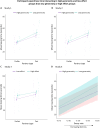Social environment-based opportunity costs dictate when people leave social interactions
- PMID: 38737130
- PMCID: PMC11081926
- DOI: 10.1038/s44271-024-00094-5
Social environment-based opportunity costs dictate when people leave social interactions
Abstract
There is an ever-increasing understanding of the cognitive mechanisms underlying how we process others' behaviours during social interactions. However, little is known about how people decide when to leave an interaction. Are these decisions shaped by alternatives in the environment - the opportunity-costs of connecting to other people? Here, participants chose when to leave partners who treated them with varying degrees of fairness, and connect to others, in social environments with different opportunity-costs. Across four studies we find people leave partners more quickly when opportunity-costs are high, both the average fairness of people in the environment and the effort required to connect to another partner. People's leaving times were accounted for by a fairness-adapted evidence accumulation model, and modulated by depression and loneliness scores. These findings demonstrate the computational processes underlying decisions to leave, and highlight atypical social time allocations as a marker of poor mental health.
Keywords: Human behaviour; Social behaviour.
© The Author(s) 2024.
Conflict of interest statement
Competing interestsThe authors declare no competing interests.
Figures




References
-
- Kupferberg, A., Bicks, L. & Hasler, G. Social functioning in major depressive disorder. Neurosci. Biobehav. Rev. 69, 313–332 (2016). - PubMed
LinkOut - more resources
Full Text Sources
